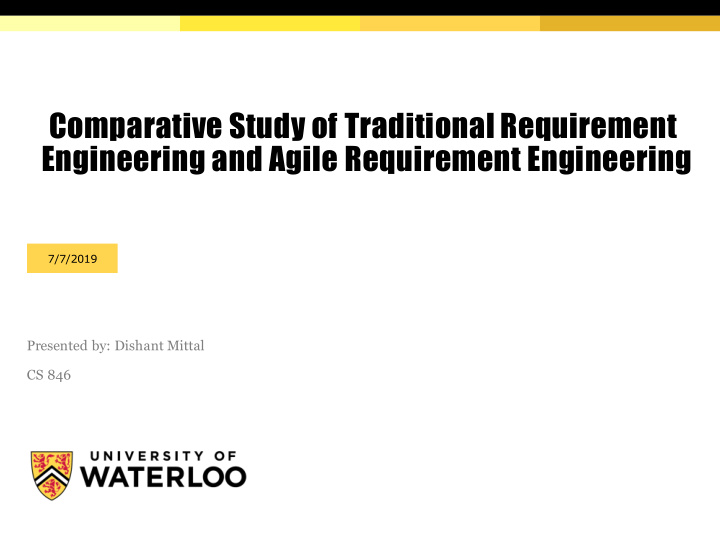



Comparative Study of Traditional Requirement Engineering and Agile Requirement Engineering 7/7/2019 Presented by: Dishant Mittal CS 846
Outline ▪ Introduction ▪ Traditional Requirement Engineering (TRE) ▪ Agile Requirement Engineering (ARE) ▪ TRE vs ARE ▪ Shift from TRE to ARE ▪ Why this shift should help? ▪ Case Study ▪ Summary
Introduction ▪ Requirement Engineering applies different techniques and methods for the requirement analysis during development of software. ▪ TRE - complicated process ▪ Need - Flexible and speedy process ▪ Solution - Agile Requirement Engineering
Traditional Requirement Engineering (TRE) ▪ Identifying, modeling, communicating and documenting the requirements for a system ▪ Paetsch et al. [2] mentioned that: ▪ Customer interaction only in early stages ▪ Describes what is to be done than how to do ▪ Prevents costly rework
Traditional Requirement Engineering Phases ▪ Elicitation – interviews, use-case, focus groups, brainstorming, prototyping ▪ Analysis and Negotiation – Joint Application Development (JAD), prioritization, modelling ▪ Documentation ▪ Validation ▪ Management
Traditional Requirement Engineering (TRE) A traditional linear iterative requirements engineering model (Batool et al. [1])
Agile Requirement Engineering (ARE) ▪ Batool et al. [1] regard ARE as: ▪ More flexible and quicker. ▪ Benefit of constant communication between customers and developers. ▪ Result: System delivered on time with customer’s expectations and better business value.
Agile Requirement Engineering - Methodologies ▪ Extreme Programming (XP) ▪ Agile Modelling ▪ Scrum ▪ Feature Driven Development (FDD) ▪ Dynamic Systems Development Method (DSDM) ▪ Adaptive Software Development (ASD)
Agile Requirement Engineering An agile collaborative and innovative framework (Batool et al. [1])
TRE vs ARE Traditional RE Agile RE Relies on Documentation Face to Face interaction Predictive Adaptive Process Oriented People oriented Include Use-Cases Includes User Stories (business centric) Realistic view of customer Assumes customer knows everything Customer involved only in the start Customer is involved throughout the SDLC Properly defined techniques Techniques defined vaguely
Shift From TRE to ARE A view of documentation within traditional and agile software developments (Batool et al. [1])
Why this shifting would help? Traditional RE Agile RE Blunt Planning Flexibility/ Adoptability as per user needs and expectations Highly technical/ Simpler unproductive(complex documentation) Lack of capability/ ability to respond to Easy to grasp evolving requirements, evolving requirements/learning welcomes new requirements (which are consistent with old ones) at any stage in SDLC Difficult to Re-organize documentation No time waste in building huge and (wastage of time) complex documentation
Case Study A project of Hospital Management Information System (HMIS) has • been developed by software team at some company. • Applied: • Traditional Requirement Engineering Agile Requirement Engineering • • 2 Data base administrators, 2 Managers, 3 Developers, 3 Technical Writers and 2 QA experts. Evaluation of the results on the basis of their expert • opinions/responses.
Case Study: Critical Factors (For Evaluation) Interviews with the experts that why they moved to agile • development: 1. Small Duration Project (SDP) 2. Project Team With Expertise (PTWE) 3. Up front Risk Analysis (URA) 4. Good Customer Relationship (GCR) 5. Face-To-Face Communication (FTFC) 6. Right Amount Of Documentation (RAOD) 7. Flexibility (FLXB) 8. Responsive To Change (RTC) 9. Correct Integration Testing (CIT) lO. Effective Delivery Management Process (EDMP)
Case Study: Results Snapshot of Comparison for Critical Success Factor (Batool et al. [1])
Case Study: Results Graphical Representation of Positive and Negative Responses in Traditional RE and Agile RE (Batool et al. [1])
Summary • Growing shift from Traditional RE to Agile RE. Agile RE is likely to perform better than Traditional RE in large organizations • where changes evolve throughout the development phase of software life cycle. (Batool et al. [1])
References [1] Batool, Asma, et al. "Comparative study of traditional requirement engineering and agile requirement engineering." 2013 15th International Conference on Advanced Communications Technology (ICACT) . IEEE, 2013. [2] Paetsch, Frauke, Armin Eberlein, and Frank Maurer. "Requirements engineering and agile software development." WET ICE 2003. Proceedings. Twelfth IEEE International Workshops on Enabling Technologies: Infrastructure for Collaborative Enterprises, 2003. . IEEE, 2003.
Recommend
More recommend